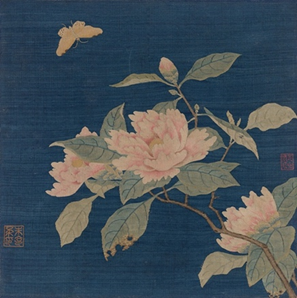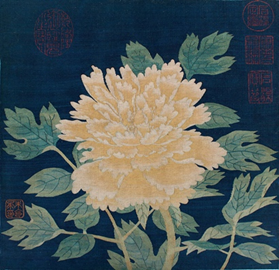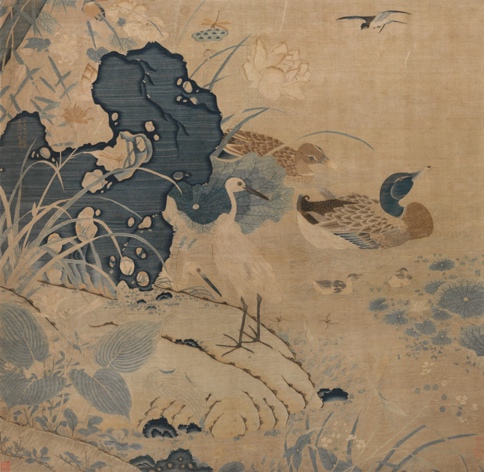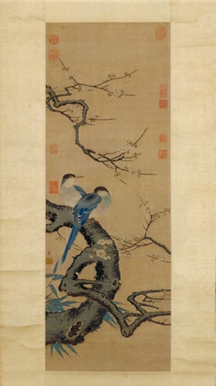1. Introduction
Silk textile was one of the most important Chinese material art, which reflects the artistic and economic life of Chinese people over thousands of years. Kesi, a kind of silk tapestry with cut designs was one with the highest technique in specialized silk textile. Centered around the concept of "investigating things to extend knowledge," the philosophy of Neo-Confucianism impacted not only the political realm but also the art of painting, and further had a significant influence on the composition, coloring, and techniques of silk textile. This article first analyzes the political environment and economic situation of the Song dynasty, and discusses the relationship between the elevation of the scholar-official class's status and the development of Neo-Confucianism against the backdrop of a unique social context. It then examines the artistic characteristics of kesi before the Song Dynasty and compares the changes afterwards, concluding with the intrinsic relationship between kesi, painting art, and Neo-Confucian philosophy.
2. The Historical Context of the Song Dynasty
2.1. The Flourishing of Culture and Arts during the Song Dynasty
Historian Chen Yinke remarked, "The culture of China, having evolved over thousands of years, reached its pinnacle during the era of the Zhao Song. Thereafter, it gradually declined, but it is bound to be revitalized." Compared to previous dynasties, the Song Dynasty's culture exhibited trends of "popularization, secularization, and humanization." Firstly, the growth of the scholarly class and the civil service examination system, which was more open and fairer than that of the Tang Dynasty, provided opportunities for many individuals from humble backgrounds. Secondly, the rise of the urban citizenry; the city of Kaifeng during the Song Dynasty was a comparatively open environment, with frequent movements among people from different social strata such as scholars, peasants, artisans, and merchants [1]. Urban prosperity and the burgeoning of the urban class forged a closer connection between art and the common people, expanding the scope of artistic expression and leading to greater diversity in subjects and styles. The royal nobility's increased demand for art, the ruling class's fondness and emphasis on art, and the trend of scholars and officials collecting paintings, calligraphy, and art objects all propelled the development of art. Moreover, the advancement of handicrafts and commerce, along with technological progress during the Song Dynasty, provided fertile ground for the development of material art.
2.2. The Scholar-Official Class and Neo-Confucianism
The Song Dynasty marked a critical period of ideological transformation in Chinese history. To prevent the political peril of regional military insubordination that had been prevalent since the late Tang Dynasty and the Five Dynasties period, the emperors of the Song adopted Confucian governance and favored the appointment of scholar-officials [1,2]. The civil service examination system, as a mechanism for selecting officials, significantly supported the entry of literati into government service, thereby gradually shaping a vast scholar-official class. This class not only inherited traditional Confucian teachings but also constructed the theoretical framework of Neo-Confucianism. Rationalism, which absorbed philosophical theories from Taoism and Buddhism, saw its status in thought and culture continually rise. By the late Southern Song Dynasty, it was adopted as the official philosophy.
3. Song Dynasty Kesi and Painting
3.1. Characteristics of Kesi before the Song Dynasty
Kesi is a type of silk weaving craft characterized by the technique of 'continuous warp and broken weft,' which uses undyed silk as the warp and colored silk as the weft. The patterns are woven using a method that involves changing shuttles and partially reversing the weft according to the contours of the design or color changes. This technique allows the weft to pass through the warp, revealing the pattern and creating boundaries with a carved effect, giving the fabric a rich, three-dimensional appearance [2]. The Encyclopædia Britannica notes that the weaving technique of continuous warp and broken weft originated in Syria and Egypt and was later passed through Persia and Central Asia to China's Xinjiang via the Pamir Plateau. Archaeological discoveries in China have uncovered kesi artifacts, such as the horse-and-rider patterned kesi wool from the Shanpula site in Hotan, the beast-head patterned kesi woolen cloth from the Keriya River site, and Han Dynasty woolen textiles unearthed in Loulan. The discovery of a kesi belt in a Tang Dynasty tomb in Turpan indicates that the emergence of China's ancient kesi craftsmanship can be dated back to no later than the Tang Dynasty.
3.2. Kesi and Painting
Since the Song Dynasty, kesi not only gradually developed and matured in skill but also underwent changes in form.
In terms of kesi technique, the Song Dynasty was more sophisticated compared to the Tang Dynasty. Although the weaving technology was the same as in the Tang Dynasty, the patterns of the Song Dynasty were more complex, and the widths of the textiles were significantly increased [2, 3]. Tang textiles, exchanged during the cultural interactions between the East and West, were mainly practical items such as ribbons, and the decorative patterns were mostly simple geometric shapes, lacking artistic depth.
The Song Dynasty's rulers valued culture over military prowess and rewarded learning and artistic skill, leading to a flourishing of scholarly pursuits. All types of handicrafts during the Song Dynasty, whether in craftsmanship or decoration, experienced unprecedented development. Among these, the technique of continuous warp and broken weft in kesi craft rapidly advanced. Kesi artists infused personal emotion into their weaving, producing kesi works with delicate and rich patterns, which provided the technical foundation for the transition of kesi from practicality to aesthetic appreciation with embedded meanings. Kesi patterns evolved from early geometric shapes to gradually integrating with painting and religious techniques during the Song Dynasty, developing into a fiber art that unified weaving and painting [4,5]. In the late Northern Song Dynasty, Emperor Huizong had a profound love for painting, greatly expanded the imperial painting academy, and developed institutions like the Wen Si Yuan and Wen Xiu Yuan for crafting court artifacts, leading to an unprecedented flourishing of court paintings and artistic works. The representational themes of Song Dynasty kesi patterns often emulated the realistic kesi works based on the Song academy style of painting. Therefore, the study of Song Dynasty kesi patterns often draws upon the aesthetic principles of Song paintings.
3.2.1. The Painting Perspective and Confucian Spirit of the Song Dynasty
The art of painting in any nation or ethnic group usually begins with the goal of 'realism,' and 'faithful reproduction' has been a long-sought aim among artists. However, due to limitations of the period, the initial works of these painters were not highly accomplished in terms of 'likeness.' It was not until the Jin and Tang dynasties that 'likeness' made significant strides, laying a solid foundation for the peak of 'realistic' painting techniques during the Song Dynasty, where the pursuit of detailed, lifelike reproduction was taken to its extreme.
A crucial factor influencing many painters' adherence to 'realism' was the Song people's reverence for 'rationalism.' The development of Neo-Confucianism during the Song Dynasty had a profound impact on all aspects of society. In painting, it was essential to follow the laws of nature and not create works arbitrarily. Historical records note that Emperor Huizong of Song was meticulous in his observation of the world around him, even considering whether a peacock steps first with its left or right foot, or the various changes in leaves over time—details he would scrutinize before painting, exemplifying his rigorous approach to the art. This attitude set a standard that many painters emulated, cultivating flowers, birds, insects, and fish, and observing them carefully for use in their life drawings.
It was this meticulous approach that led to Song Dynasty painters favoring the portrayal of detailed scenes in their work. The paintings of the era are filled with a conservative and rational style, marked by precise realism. Kesi adopted this characteristic; in the shaping of objects, the control of form and color was almost indistinguishable from their real-life counterparts, avoiding the exaggerated deformations and strong contrasts in color common in other silk fabrics [2, 5-6]. The pursuit of realism and fine detail remained the goal of Song Dynasty painting, as evidenced by the realistic style and exquisite fine lines found throughout the works of the period.
3.2.2. Characteristics of Kesi Painting
Neo-Confucian scholars of the Song Dynasty advocated for the practice of self-cultivation through 'investigation of things to extend knowledge' to meet the standards of 'heavenly principle.' The aesthetic principle of the imperial painting academy was 'meticulous imitation of nature,' valuing the 'methods' of the ancients and strictly adhering to the 'likeness' of natural phenomena, taking the pursuit of detailed and realistic depiction of details to its zenith. Guo Ruoxu, in his 'Tuhua Jianwen Zhi' (Records of Observations on Painting), discussed flower and bird paintings, suggesting that one should understand 'the conditions of the four seasons, the facing of yin and yang, the age of bamboo shoots, the sequence of buds and sepals as well as the forms and features of various birds.' To portray objects authentically, many painters raised flowers, birds, insects, and fish themselves, observing and sketching them meticulously. During the reign of Emperor Zhenzong, the painter Zhao Chang, in pursuit of faithfully reflecting reality through color, often went to the garden in the early morning while the dew was still fresh to observe and mix colors, thereby earning the reputation for 'lifelike portrayal unmatched by his contemporaries.' Consequently, the painters' approach to creation was quite rigorous; they observed nature deeply and thoroughly, from the exterior to the interior, and had a profound experience with every bird, insect, grass, flower, mountain, and body of water. They not only captured the true form of the subjects they painted but also grasped the essence of the objects, achieving 'investigation of things to manifest truth, and likeness to generate meaning.' This pursuit of detail and authenticity became an important aesthetic standard in the imperial painting academy, increasingly becoming a prominent trend and interest in the artistic community, from within the academy to the outside [6, 7]. As the decorative aspect of painting was enhanced, arts and crafts borrowed elements from painting to strengthen their own visual appeal. At this time, the integration of arts and crafts with painting became even tighter, permeating the shadows of Song Dynasty painting everywhere, and the realistic style also significantly influenced the institutions and workshops within the palace, such as the Wen Si Yuan, Jia Ku, Wen Xiu Yuan, and Lian Jin Yuan, which produced craft items. As known from the 'Yunqing Xuan Mi Lu' (Secret Records of the Yunqing Pavilion), the embroidery products of the time were influenced by the academy style paintings: 'Landscapes convey the charm of distance and proximity, pavilions and towers achieve a depth of form, figures possess a vivid sense of contemplation and observation, and flowers and birds exhibit an elegant and lively demeanor. The finest among these surpass even paintings in their beauty.
3.3. Style Analysis of Representative Works and Neo-Confucianism
The influence of Neo-Confucian philosophical thought of the Song Dynasty on art extended from the realm of painting to the representative of material art—kesi.
3.3.1. Composition
In the Song Dynasty, kesi depictions of flowers and birds were often small in scale, typically featuring a branch of flowers bending into the picture from one corner or side, with birds or insects added as embellishments. This not only balanced the composition but also brought vitality to the scene. This was a common compositional method in Song Dynasty flower and bird paintings, which not only allowed for a delicate and vivid portrayal of the subjects but also imparted an exquisitely unique sensation to the viewer. Figure 1 'Kesi Camellia and Butterfly' is a masterpiece by the renowned kesi artist Zhu Kerou. In the piece, a blue background sets the stage, with a cluster of floral branches extending from the bottom right corner. The flowers are depicted in varying states of bloom—some partially open, some bud-like, about to unfurl. The shape and texture of the pinkish sepals are rendered with subtle delicacy; the leaves are spaced to create density and rhythm, with both flattened and turned states represented. The veins of the leaves and branches are clearly defined, and the depiction of insect-eaten, yellowing leaves, based on direct observation from life, significantly enhances the realism of the work. Similar detailed depictions of branches and leaves can be seen in Lin Chun's 'Birds Attracted by Ripe Fruit' and a Song-era 'Camellia and Butterfly.' The petals and leaves transition in color naturally, reminiscent of the fine-brush gradient effect; a butterfly alighting on a branch adds dynamism to the entire scene, as if a light breeze were blowing and the scent of flowers was in the air. The signature 'Seal of Zhu Kerou' is woven in the lower-left corner. This image is a typical Northern Song academy style of flower and bird painting. The weaver's use of various colored silk threads is distinctive, such as using brown and beige for withered branches, green and yellow-green for leaves, and the most challenging depiction of insect damage is woven with beige and brown threads to create a natural color transition [7, 8]. The fine sepals are rendered in varying lengths using the herringbone technique to create depth, while the stamens use beige and yellow, with the technique reducing the gap between stitches and adding detailed stippling and retouching according to the layers, for a flatter and more natural effect. Retouching is a common technique in kesi, and in 'Kesi Camellia and Butterfly,' details like sepals and branches, as well as the parts of leaves damaged by insects, are all enhanced with localized stippling. Where there are omissions in the weaving, the retouching method can be employed to achieve the best effect.

Figure 1: 'Kesi Camellia and Butterfly' by Zhu Kerou
3.3.2. Coloration
Due to the emulation and borrowing from painting, ornamental kesi also adheres to the principle of 'assigning colors according to type' found in painting, applying colors in accordance with the natural hues of the objects depicted. Zhang Xizhi once praised Zhu Kerou's 'Kesi Peony' (Figure 2: ' Kesi Peony by Zhu Kerou): 'This piece, just over a square foot, is all delicately detailed, as if drawing from a single silkworm thread, containing five colors, intricately adorned and meandering, a work of natural ingenuity. The excellence of its needlework surely sets it as a Song dynasty creation without doubt.' The various colors in 'Kesi Peony' differentiate from each other yet harmonize and unify, maintaining integrity amidst variation, reflecting the Song people's reverence for Neo-Confucianism. A focus on realism and meticulous craftsmanship has always been the goal pursued by Song dynasty painting.

Figure 2: ' Kesi Peony by Zhu Kerou
 In the kesi works featuring flowers and birds, there is also the 'Lotus Pond with Ducks' (Figure 3: 'Lotus Pond with Ducks' by Zhu Kerou) in the academy and freehand style, which is a larger piece and a representative work of Zhu Kerou. This piece is rich in coloration, with a composition that possesses a sense of depth and narrative. It portrays a pair of mallard ducks, two ducklings, two egrets, and a kingfisher, some frolicking in the pond, others soaring close to the water, all vividly lifelike. Interspersed among them are dragonflies and grass insects, while in the water float lotuses, lily pads, hibiscus, white lotus, and water lilies interspersed among Taihu rocks and the shoreline, all arranged in an orderly manner that combines stillness with motion, creating a tranquil scene. The piece is marked with 'Made by Zhu Gang from Jiangdong, Lotus Pond with Ducks' and 'Seal of Zhu Kerou.' All the flora, fauna, and birds in the image are realistically rendered, likely drawn from life, with the proportions of the animals and plants true to scale. The scene of the lotus pond, based on the size of the ducklings and the state of the flowers, is inferred to represent a late spring to early summer setting. Throughout the image, flowers are either budding or fruiting, and birds and insects are paired, suggesting companionship.
In the kesi works featuring flowers and birds, there is also the 'Lotus Pond with Ducks' (Figure 3: 'Lotus Pond with Ducks' by Zhu Kerou) in the academy and freehand style, which is a larger piece and a representative work of Zhu Kerou. This piece is rich in coloration, with a composition that possesses a sense of depth and narrative. It portrays a pair of mallard ducks, two ducklings, two egrets, and a kingfisher, some frolicking in the pond, others soaring close to the water, all vividly lifelike. Interspersed among them are dragonflies and grass insects, while in the water float lotuses, lily pads, hibiscus, white lotus, and water lilies interspersed among Taihu rocks and the shoreline, all arranged in an orderly manner that combines stillness with motion, creating a tranquil scene. The piece is marked with 'Made by Zhu Gang from Jiangdong, Lotus Pond with Ducks' and 'Seal of Zhu Kerou.' All the flora, fauna, and birds in the image are realistically rendered, likely drawn from life, with the proportions of the animals and plants true to scale. The scene of the lotus pond, based on the size of the ducklings and the state of the flowers, is inferred to represent a late spring to early summer setting. Throughout the image, flowers are either budding or fruiting, and birds and insects are paired, suggesting companionship.
Figure 3: 'Lotus Pond with Ducks' by Zhu Kerou
3.3.3. Technique
Shen Zifan was a master of kesi weaving during the Southern Song Dynasty. His kesi works often took famous calligraphy and paintings as prototypes, with compositions that were simple and styles that were light, elegant, and antique. He was skilled in using techniques such as the wooden comb herringbone, wrapped heart herringbone, and phoenix tail herringbone. His depiction of bird feathers was vivid and lifelike, leaving no traces of carving, which presented a strong sense of pictorial art. Figure 4 'Kesi Plum Blossoms with Cold Magpies' inherited the painting methods of Huang Quan’s academy style of flowers and birds, utilizing ink painting techniques for stippling the branches of the tree and fine brush painting techniques to depict the magpies and plum blossoms. The tree branches are robust and vigorous, with two magpies standing opposite each other, their feather textures enhanced by the fineness of the silk, achieving effects even superior to painting. The plum blossoms on the branches are in various states, from fully bloomed to bud, each with a distinct form. A cluster of green bamboo is interspersed among the branches, with bamboo leaves also showing different shades of yellow-green and the detail of insect-eaten leaves. The fine details are meticulously rendered, showing a mastery of both expressive and meticulous brushwork, exemplifying a perfect fusion of painting and kesi weaving techniques [7, 9]. The bottom of the work is woven with 'Made by Zifan' and the 'Shen Family' seal, while the poem hall bears Qianlong's imperial brush 'Joy Gives Rise to Fragrance,' and is stamped with multiple seals such as 'Qianlong's Appreciation,' 'For the Progeny,' 'Treasure Inspected by Jiaqing,' 'Qianlong's Imperial Hand,' 'Shiqu Baoji,' 'Definitive Shiqu Examination,' 'Recompiled Treasure Records,' 'Fruit Prince Mansion Book Record,' 'For the Descendants to Cherish,' 'Liang Family of the Banana Forest Calligraphy and Painting Seal,' among others. There is also Shen Zifan's 'Kesi Flowers and Birds,' which introduces thick and thin peach branches into the picture, with two doves standing on the thick branches, thin branches extending upwards, flowers abundant and leaves lush. The peach blossoms vary in state from blooming to budding, with contorted tree trunks outlined in ink, and the piece signed with 'Zifan.'

Figure 4: 'Kesi Plum Blossoms with Cold Magpies' by Shen Zifan
4. Conclusion
Song dynasty flower and bird paintings emphasized observation of nature, capturing the essence of natural objects with refined brushwork that achieved both realism and spirit. This was closely related to the ideological transformation of Neo-Confucianism during the Song dynasty. The prosperity of painting also influenced kesi (silk tapestry). The ornamental kesi of the Song dynasty as a material artistry, similar with the style of flower and bird paintings of the period, focused on the realistic depiction of objects, using silk as a substitute for the brush. Through a variety of techniques, it conveyed the characteristics and texture of different objects. In terms of composition, coloration, and expressive techniques, both forms of art demonstrated a remarkable harmony.
References
[1]. Yao, Yingting. (1995). Culture History of Song, p. 605.
[2]. Tong, Wene. (2009) Kesi in Song Dynasty: Flower and Bird Exhibition collection, p. 58-60.
[3]. Xu, Shucheng. (2000). Painting History of Song Dynasty, p. 69-104.
[4]. Zhu Xinyu, ed. (2009) Theory of Chinese Silk, p. 51
[5]. Loewe, Michael and Edward L. Shaughnessy. (1999) The Cambridge History of China: From the Origins of Civilization to 221 BC, p. 581.
[6]. Liu Xinru. (1998) Silk and Religion: an exploration of material life and the thought of people AD 600-1200.
[7]. Zhao Feng. (1999) Treasures in silk, p. 153.
[8]. Bray, Francesca. (1997) Technology and Gender: Fabrics of Power in Late Imperial China, Retrieved from https://www.jstor.org/stable/jj.5232966
[9]. Liu, Heping and Artibus, Asiae. (2003) Empress Liu’s Icon of Maitreya: Portraiture and Privacy at the Early Song Court, Artibus Asiae 63, no 2 (2003): 129-190.
Cite this article
Wu,Y.;Wang,C. (2024). Exploring the Impact of Neo-Confucianism on Material Art Through the Artistic Characteristics of Kesi in Song Dynasty. Lecture Notes in Education Psychology and Public Media,51,249-255.
Data availability
The datasets used and/or analyzed during the current study will be available from the authors upon reasonable request.
Disclaimer/Publisher's Note
The statements, opinions and data contained in all publications are solely those of the individual author(s) and contributor(s) and not of EWA Publishing and/or the editor(s). EWA Publishing and/or the editor(s) disclaim responsibility for any injury to people or property resulting from any ideas, methods, instructions or products referred to in the content.
About volume
Volume title: Proceedings of the 2nd International Conference on Social Psychology and Humanity Studies
© 2024 by the author(s). Licensee EWA Publishing, Oxford, UK. This article is an open access article distributed under the terms and
conditions of the Creative Commons Attribution (CC BY) license. Authors who
publish this series agree to the following terms:
1. Authors retain copyright and grant the series right of first publication with the work simultaneously licensed under a Creative Commons
Attribution License that allows others to share the work with an acknowledgment of the work's authorship and initial publication in this
series.
2. Authors are able to enter into separate, additional contractual arrangements for the non-exclusive distribution of the series's published
version of the work (e.g., post it to an institutional repository or publish it in a book), with an acknowledgment of its initial
publication in this series.
3. Authors are permitted and encouraged to post their work online (e.g., in institutional repositories or on their website) prior to and
during the submission process, as it can lead to productive exchanges, as well as earlier and greater citation of published work (See
Open access policy for details).
References
[1]. Yao, Yingting. (1995). Culture History of Song, p. 605.
[2]. Tong, Wene. (2009) Kesi in Song Dynasty: Flower and Bird Exhibition collection, p. 58-60.
[3]. Xu, Shucheng. (2000). Painting History of Song Dynasty, p. 69-104.
[4]. Zhu Xinyu, ed. (2009) Theory of Chinese Silk, p. 51
[5]. Loewe, Michael and Edward L. Shaughnessy. (1999) The Cambridge History of China: From the Origins of Civilization to 221 BC, p. 581.
[6]. Liu Xinru. (1998) Silk and Religion: an exploration of material life and the thought of people AD 600-1200.
[7]. Zhao Feng. (1999) Treasures in silk, p. 153.
[8]. Bray, Francesca. (1997) Technology and Gender: Fabrics of Power in Late Imperial China, Retrieved from https://www.jstor.org/stable/jj.5232966
[9]. Liu, Heping and Artibus, Asiae. (2003) Empress Liu’s Icon of Maitreya: Portraiture and Privacy at the Early Song Court, Artibus Asiae 63, no 2 (2003): 129-190.









